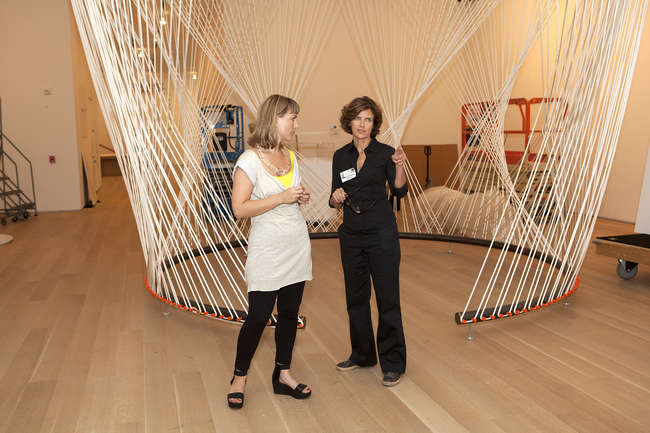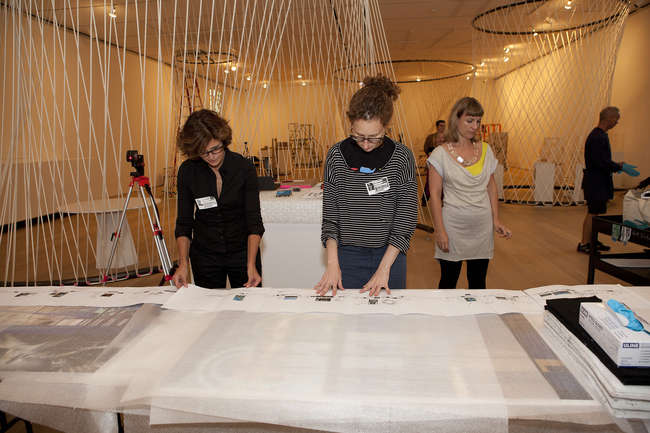
Though it focuses on the work of Chicago architect Jeanne Gang, Building: Inside Studio Gang Architects at the Art Institute of Chicago is not a retrospective. Rather than chronicling the evolution of the MacArthur Fellow’s talent, it focuses instead on the visionary and collaborative thinking of her studio.
 |
|
Photo courtesy the Art Institute of Chicago
Jeanne Gang (far left) helps prepare portions of the exhibition.
|
Organized by the Art Institute’s architecture and design curator, Zoë Ryan, and assistant curator Karen Kice, and on view through February 24, 2013, the show highlights 13 projects by the firm.They range from built work such as Chicago’s Aqua Tower to conceptual projects and competition entries including stunning models and renderings for the Kaohsiung Maritime Cultural & Pop Music Center in Taiwan.
Navigating the show’s two adjoining gallery spaces in the museum’s Modern Wing, visitors first encounter a variety of models, renderings, and video projections of Studio Gang’s projects. There is plenty to see here, including a graceful, gossamer-like model of Aqua. A copied photograph of it has handwritten notes indicating which parts of the building’s undulating balconies are “flares,” “clefts,” or “waves.” The show also gives space and attention to a community center Gang designed for SOS Children’s Villages on the city’s South Side. The center is a playful piece of architecture on a lesser-traveled street in a working-class neighborhood. It is good to see it highlighted here.
The second gallery space is set up like a workshop, with everything from tools to mock-ups on display. The development of the firm’s three-sided Arcus Center for Social Justice Leadership—a small upcoming project in Kalamazoo, Michigan, that will feature exterior walls constructed with white-cedar masonry, a technique once common in the region—is told in 168 renderings and working drawings pinned to a gallery wall. A round table for reading and discussion sits in the middle of the space, along with a curved, laminated Douglas fir mock-up for Gang’s well-received pavilion at Chicago’s Lincoln Park.
There are some things to quibble about in the exhibition. The four “Rope Rooms” in the main gallery—they look like a cross between a tepee and a giant basketball net—add nothing to the accompanying video and projects. And although Gang is worthy of a show at a major museum, one can’t help but wonder if this one is a few years too soon, given that many of the large-scale projects featured in the exhibition are stalled or unbuilt. Even the Kaohsiung center, impressive as it is, took third place in the design competition for which it was submitted. The show could feel more robust in three to five years, when, if the economy improves, the firm could have more large-scale work to demonstrate the fruits of its process. Still, Building is an attractive, informative, and well-executed show that conveys the talents and abilities of Gang and her team—and it demonstrates why she’s become such a force.

Post a comment to this article
Report Abusive Comment